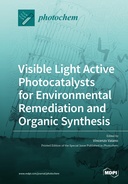Explore

Visible Light Active Photocatalysts for Environmental Remediation and Organic Synthesis
0 Ungluers have
Faved this Work
Login to Fave
In recent years, the formulation of innovative photocatalysts activated by visible or solar light has been attracting increasing attention because of their notable potential for environmental remediation and use in organic synthesis reactions. Generally, the strategies for the development of visible-light-active photocatalysts are mainly focused on enhancing degradation efficiency (in the case of environmental remediation) or increasing selectivity toward the desired product (in the case of organic synthesis). These goals can be achieved by doping the semiconductor lattice with metal and/or non-metal elements in order to reduce band gap energy, thereby providing the semiconductor with the ability to absorb light at a wavelength higher than the UV range. Other interesting options are the formulation of different types of heterojunctions (to increase visible absorption properties and to reduce the recombination rate of charge carriers) and the development of innovative catalytic materials with semiconducting properties. This reprint is focused on visible-light-active photocatalysts for environmental remediation and organic synthesis, featuring the state of the art as well as advances in this field.
This book is included in DOAB.
Why read this book? Have your say.
You must be logged in to comment.
Rights Information
Are you the author or publisher of this work? If so, you can claim it as yours by registering as an Unglue.it rights holder.Downloads
This work has been downloaded 120 times via unglue.it ebook links.
- 120 - pdf (CC BY) at Unglue.it.
Keywords
- acetaminophen
- activated carbon
- Ag/Cu2O
- Ag3PO4
- azo dyes
- bacterial photoinactivation
- BB41 dye
- Biomass
- Box–Behnken design
- C3N4
- carbon composite nanofibers
- cobalt
- composite
- Cr(VI) reduction
- decolorization
- diamond nanocrystals
- electrospinning
- Green chemistry
- heterostructure
- History of engineering & technology
- hydrophosphination
- Materials science
- Mechanical engineering & materials
- MoS2
- n/a
- nanocatalysis
- nanohybrid
- nitrobenzene
- Optical properties
- oxygen and argon gas flow rates
- persulfate
- phosphines
- photocatalysis
- photocatalyst
- photocatalytic activity
- photocatalytic oxidation
- photodegradation
- Remazol Black
- response surface method
- Rietveld method
- sillenite Bi12NiO19
- sulfate radical
- Sulfur
- Sunlight
- Technology, engineering, agriculture
- Technology: general issues
- TiO2
- TiO2 thin film
- visible light
- waste
- Water pollution
- zirconium
Links
DOI: 10.3390/books978-3-0365-3647-7Editions

